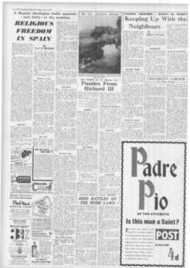Page 4, 1st June 1956
Page 4

Report an error
Noticed an error on this page?If you've noticed an error in this article please click here to report it.
Tags
Share
Related articles
Catholic Heraldry Of A Very Different Kind
In A Few Words
Ecclesiastical
Vatican To Rule On Dissent
Archbishop Bruno Heim. The Swissborn Apostolic Delegate...
THE SOVEREIGN PONTIFF HAS THE OLDEST COAT OF ARMS
lig JOHN A. GOODALL
N THE CATHOLIC HERALD for May 18. following a letter deploring the neglect of the Papal flag, Jotter posed certain questions.
These are briefly the question of the relationship between the Papal flag. the Vatican City State and the Church at large; whether a flag or standard is opposed to the nature of the Church; and finally whether the Established Church possesses a flag of its own.
The history of the coat of arms of the Papacy can be proved, on contemporary evidence, to he older than any other coat of arms. In its latest form, however. it dates only from the 15th century and, like so mans medieval coats of arms, was changed from time to time.
The chronicler Orderic Vitalis. in his Ecclesiastical History, records that in 1059 Pope Nicholas 11 appointed William of Montreuil to be the gonfalonier or standardhearer of the Roman See. it is therefore certain that there was a more or less generally recognised banner of the Church at this time.
Throughout the 11th and 12th centuries the chronicles mention several gifts of specially blessed flags to the leaders of military expeditions undertaken with the approval of the Pope.
The one given to William. Duke of Normandy, for the conquest of England is twice depicted on the Bayeux Tapestry. Apart from this one example. little is known for certain about the design of these banners until the 13th century.
TWO KEYS
TN 1203 Pope Innocent HI sent a flag to Kaloyan, Tsar of the Bulgars and Vlachs, with a letter explaining the symbolism of the cross and keys depicted on it as the cross of Christ and the keys of St. Peter.
These arms. often with four pairs of keys crossed in saliire between the limbs of the cross. are still to be seen on several buildings in Italy as the arms of the Papacy before about 1380.
The early 14th century, however, saw the introduction of a new coat of arms consisting simply of two keys crossed in saitire and sometimes linked through the bows by a cord.
The field of the shield is gules (red) and the keys either gold or silver: the practice of placing a gold key in bend over another in bend sinister of silver is not found with any certainty before the time of Pius II (1458-64
In the 15th century the second emblem of the Papacy, the tiara, which in earlier examples is placed over the top of the shield containing the keys, was placed inside the shield. The resulting coat of arms belongs to the Papacy in its spiritual capacity and may not he used by any one other than the Pope and his diplomatic representatives.
OMBRELLINO
THE third emblem of the Papacy is the otnbrellino or pavilion.
It is found as a badge, with the crossed keys overlying the staff, from the time of Alexander VI (1492-1503) and appears to have been used as a coat of arms for the Papal States in the reign of Gregory XIII (1572-85). Later it appears as one of the quarterings in the arms of the Napoleontc kingdom of Italy again for the Papal States. It is used between the death of a Pope and the election of his successor.
In most of the 15th century hooks of arms painted in Germany, besides the coats of arms of the Papacy, the Church and Chapter of St. Peter's, and the City of Rome, another coat is given for the Church. This is silver a cross gide; with the traverse arms enarched: possibly this was done to distinguish them from the coat of armN assigned to St. George in the late 13th century (silver a cross gules). These arms are alluded to, with the tinctures reversed and a plain cross, by Bernard du Rosier, a 15th century French Bishop, in his Book of Arms, as those proper to all faithful Christians. (Extracts of this interesting work are printed in Mgr. B. B. Heim's book, " Couturnes et Droits Heraldiques de l'Eglise," 1949.)
NEW COLOURS
£-:1_ century the beginning of the 19th century the Papacy used a flag of red and gold, the livery colours derived from the arms I have described above, and these were changed to silver and gold by Pius VII (1800-20) after the usurpation of the original colours by the. French arms of occupation.
In a volume of letters addressed to Alban Buckler, Surrey Herald Extraordinary, now preserved in the British Museum (Add, Ms. 37146) there is a letter from Hartwell de la Grissell, one of the Chamberlains to Popes Pius IX and Leo XI11. The following extracts are relevant to the present enquiry. (It is dated from Rome. July 12, I887.):
" This flag [parted vertically silver and gold] is not older than the time of Pius VII, who changed the colours to white and yellow as the French army of occupation had usurped the Papal Colours, red and veIlw. The last time the Papal flag was seen in Rome was on September 20, 1870, when I saw it with my own eyes lowered on the Castel Sant Angelo and the Italian one take its place! The Palatine guard and the Gendarmerie and Noble Guard have also their flags of white and yellow. and the Swiss Guard have also a smaller one,"
USE OF FLAG
-r HAVE been unable to dis-L cover when the tiara and crossed keys were added to this flag, but their use on it accords with the law of arms.
The crossed keys and tiara, besides serving as the personal timbre or crest of the reigning Pope, have been used as the badge of the Papacy by soldiers in the Papal armies and others.
A badge is properly displayed on the livery colours of its owner and is worn by his retainers and followers. The Papal flag can therefore be properle flown on all suitable occasions not only from churches but also by all Catholics as subjects* of the Pope.
HE banner of St. George, bearing the arms attributed to him at the end of the 13th century, is not the flag of the Established Church. Mr. A. C. Cole, FitzAlan Pursuivant of Arms Extraordinary, has kindly given me a note about some correspon
dence which appeared on this subject in The Sunday Times during December, 1952.
On December 7 Sir Gerald Wollaston protested against the statement that the flag of St. George was the official flag of the Church of England and that it was the only flag that should properly he flown from Church of England buildings.
Sir Gerald, now Norroy and Ulster, and formerly Garter King of Arms, goes on to say that 14 years ago (i.e., in 1938) " it was officially laid down, at the request of the Archbishops of Canterbury and York, that the flag of the Church of England is the flag of St. George with an escutcheon of the arms of the Diocese in the first quarter--not the flag of St, George."
There has been further correspondence on this in The Tunes from April 26 to May 5, 1950. *Spiritual subjects.--EDITOR.
blog comments powered by Disqus









